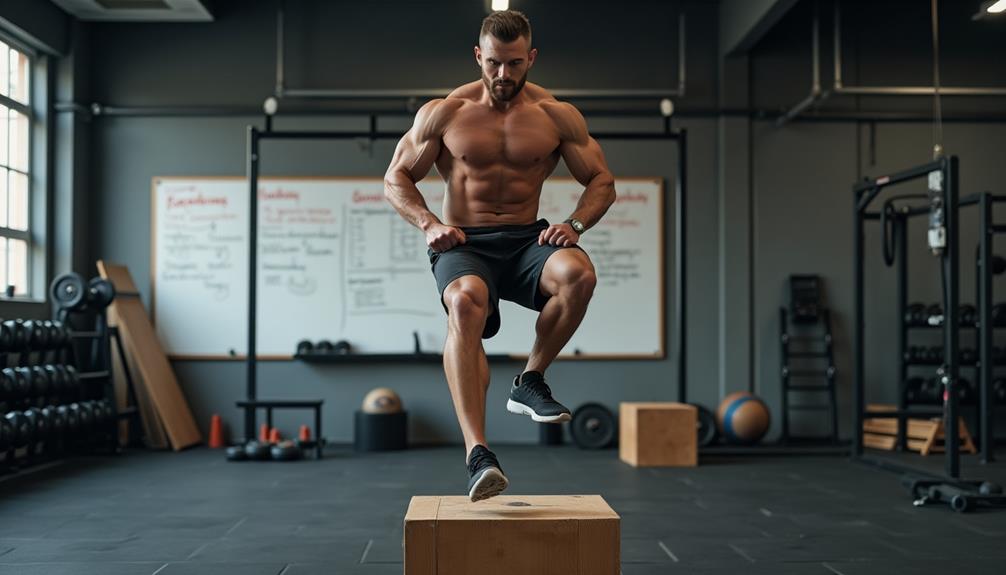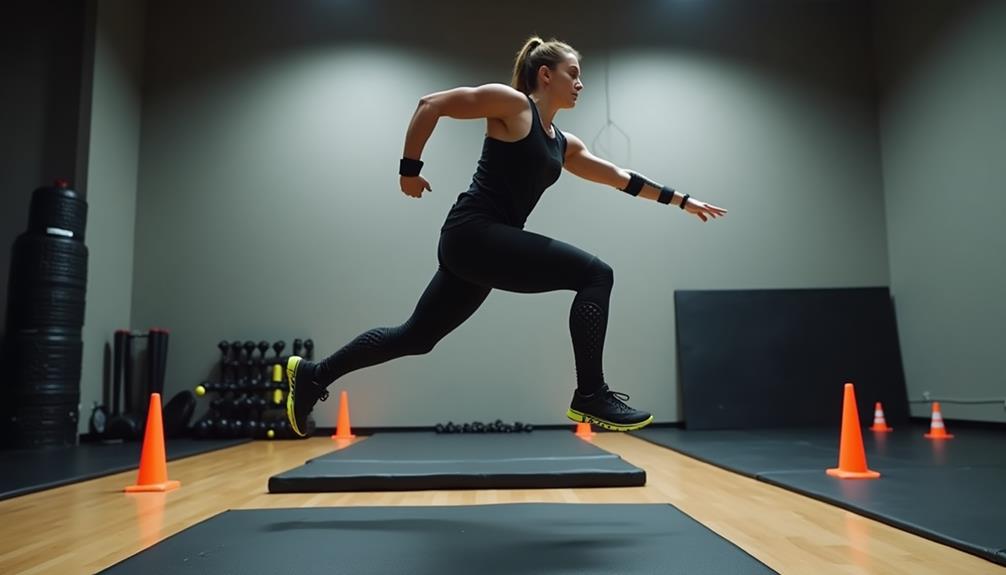To master plyometric resistance training, start by understanding its explosive movements combined with resistance. This approach enhances speed, agility, and muscle strength. Key techniques include focusing on proper landing mechanics and breathing during exercises, while ensuring safety through appropriate footwear and surfaces. Incorporate essential exercises like box jumps, broad jumps, and lateral bounds into your routine. When designing your program, assess your fitness level and set specific goals, aiming for 2-3 sessions weekly. Finally, track your progress with a journal or app for motivation and insights. With these steps, you'll build a solid foundation for your plyometric training journey.
Core Insights
- Start by defining your fitness goals and assessing your current level to tailor your plyometric training program effectively.
- Master essential techniques like landing mechanics and explosive power to enhance your performance and reduce injury risks.
- Incorporate a variety of exercises such as box jumps, depth jumps, and lateral bounds to target different muscle groups.
- Schedule 2-3 training sessions per week, ensuring proper warm-up, cool-down, and adequate recovery time between sessions.
- Track your progress using a workout journal or fitness app to stay motivated and refine your techniques over time.
Understanding Plyometric Resistance Training

While many people associate plyometric training with explosive movements, understanding plyometric resistance training requires recognizing how it combines these dynamic exercises with resistance elements. This approach enhances both strength and power. Medicine balls are excellent tools for incorporating resistance into plyometric exercises, offering versatility and scalability for various fitness levels. Fundamentally, you're performing high-intensity movements, like jumps or bounds, while incorporating weights or resistance bands.
This combination challenges your muscles differently than traditional training, promoting better muscle coordination and performance. You might use weighted vests, resistance bands, or medicine balls to increase the load during your workouts.
Incorporating resistance helps improve your overall stability and balance. It's vital to focus on technique and gradually increase resistance to prevent injury. By embracing these elements, you'll develop a more robust and powerful athletic foundation.
Benefits of Plyometric Training

Plyometric training offers numerous benefits that go beyond just building explosive power. First, it enhances your overall athletic performance by improving speed, agility, and coordination. You'll notice quicker reaction times, which can give you an edge in sports. For those experiencing muscle soreness after intense plyometric sessions, infrared heat pads can provide effective relief and aid in recovery.
Additionally, plyometrics can boost your muscle strength and endurance. By incorporating these exercises, you engage multiple muscle groups, leading to better functional fitness.
You'll also enjoy improved joint stability and flexibility, reducing the risk of injuries during other workouts or activities.
Key Techniques to Master

To excel in plyometric resistance training, mastering key techniques is essential. First, focus on your landing mechanics. A gentle landing reduces impact and injury risk. Bend your knees and keep your feet shoulder-width apart. Next, develop explosive power. Utilize quick, forceful movements to enhance your athletic performance. Incorporate proper breathing techniques; exhale during exertion to maintain core stability. Consider using cooling gel packs between training sessions to aid in recovery and reduce inflammation, especially for high-intensity plyometric exercises.
Additionally, emphasize tempo control. Move smoothly between eccentric and concentric phases for maximum effectiveness. Finally, always prioritize safety. Use appropriate footwear and train on suitable surfaces to prevent injuries. Consistently practicing these techniques will lead to improved performance and better results. As you refine these skills, you'll find yourself more prepared for the challenges ahead in your plyometric training journey.
Essential Plyometric Exercises

Incorporating essential plyometric exercises into your routine can greatly enhance your athletic performance. These exercises focus on explosive movements, improving your power and agility. Here are some key exercises you should consider:
| Exercise | Benefits |
|---|---|
| Box Jumps | Builds lower body strength |
| Depth Jumps | Enhances reactive strength |
| Broad Jumps | Improves horizontal power |
| Lateral Bounds | Boosts lateral agility |
When you add these exercises into your regimen, you'll notice improvements in your speed and overall athleticism. Start with basic variations, gradually increasing the intensity as you become more comfortable. Remember to maintain proper form to prevent injuries. Prioritize these exercises to reveal your full potential.
Designing Your Training Program

Creating an effective training program for plyometric resistance training can greatly enhance your athletic performance. Start by defining your goals. Do you want to improve speed, power, or agility? Next, assess your current fitness level. This helps tailor your program to your specific needs.
Incorporate a variety of exercises targeting different muscle groups. A balanced routine includes lower body, upper body, and core exercises. Aim for 2-3 sessions per week, allowing adequate recovery between workouts.
Progressively increase the intensity by adding weights, increasing repetitions, or shortening rest periods. Don't forget to include a warm-up and cool-down in each session to prevent injury.
Safety Precautions to Consider

As you design your plyometric resistance training program, keeping safety precautions in mind is essential to prevent injuries. Here are some key considerations:
- Warm-Up Properly: Always start with a dynamic warm-up to prepare your muscles and joints.
- Use Proper Technique: Focus on your form to avoid strain and maximize effectiveness.
- Choose Appropriate Surfaces: Train on suitable surfaces, like grass or rubber, to reduce impact stress on your joints.
- Listen to Your Body: Pay attention to any signs of discomfort or fatigue, and allow adequate recovery time between sessions.
Tracking Your Progress

Tracking your progress in plyometric resistance training is essential for understanding your improvements and adjusting your program accordingly. Start by keeping a workout journal. Note your exercises, sets, reps, and any modifications. This helps you see patterns over time.
Next, consider using a fitness app to log your workouts and track your performance metrics, such as jump height or speed. Regularly assess these metrics to gauge improvement.
Don't forget to take photos or videos of your techniques. This visual feedback can highlight changes in your form and power.
Lastly, set specific, measurable goals for yourself. Regularly review these goals to stay motivated and focused. With consistent tracking, you'll gain insights that lead to better results in your plyometric training.
Frequently Asked Questions
Can Beginners Safely Start Plyometric Resistance Training?
Yes, beginners can safely start plyometric resistance training. In fact, studies show that 70% of new athletes experience improved strength and coordination within weeks. Just make sure you focus on proper form and gradually increase intensity.
What Equipment Is Necessary for Plyometric Exercises?
For plyometric exercises, you'll need basic equipment like a sturdy box for jumps, resistance bands for added intensity, a medicine ball for explosive movements, and a mat for comfort during floor exercises. It's essential for safety.
How Often Should I Perform Plyometric Training?
You should perform plyometric training about two to three times a week. This frequency allows your muscles to recover while still building strength and power. Just listen to your body and adjust as needed.
Can Plyometric Training Improve Athletic Performance?
Plyometric training can skyrocket your athletic performance! By incorporating explosive movements, you'll enhance your speed, power, and agility. Just commit to regular sessions, and watch your skills reach new heights you never thought possible!
What Should I Eat to Support Plyometric Training?
To support your plyometric training, focus on a balanced diet rich in lean proteins, complex carbohydrates, and healthy fats. Stay hydrated, and consider timing your meals around workouts for best energy and recovery.

